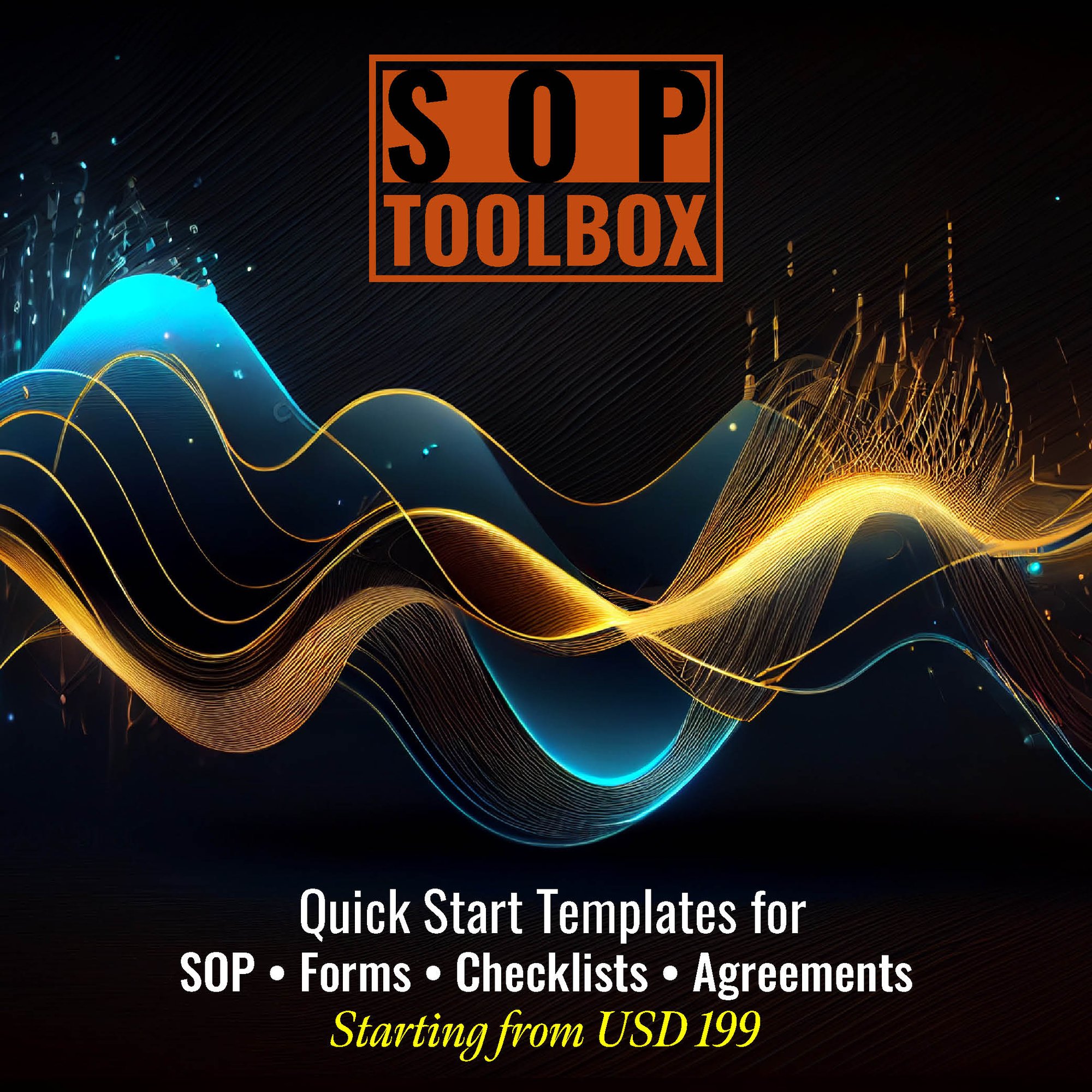The consequence of implementing an SOP (Standard Operating Procedure) Manual for the Administration of Air and Water Resource and Solid Waste Management Programs is profound in environmental stewardship and regulatory compliance. This manual serves as a comprehensive guide, outlining standardized procedures for program planning, monitoring, and evaluation.
Firstly, the SOP Manual ensures consistent and effective administration of environmental programs, reducing the impact of air and water pollution and promoting sustainable solid waste management practices.
Secondly, it becomes a vital resource for employee training, fostering expertise in environmental regulations, data collection, and compliance with waste management protocols.
Thirdly, the consequence is enhanced risk management, as the manual provides guidelines for regulatory compliance, emergency response, and ethical environmental practices. This is essential for minimizing legal and operational risks associated with environmental management.
Overall, the consequence of the SOP Manual is a more resilient, compliant, and environmentally responsible approach to the administration of air and water resource and solid waste management programs, contributing to the preservation and protection of natural resources.
CLICK HERE to download the List of SOPs Document in PDF format. Please share this document with your clients, colleagues and senior officers.
Top 50 Standard Operating Procedures (SOPs) for Administration of Air and Water Resource and Solid Waste Management Programs
SOP-061-001: Standard Operating Procedure for Air Quality Monitoring
SOP-061-002: Standard Operating Procedure for Emission Inventory Management
SOP-061-003: Standard Operating Procedure for permitting process
SOP-061-004: Standard Operating Procedure for complaint handling
SOP-061-005: Standard Operating Procedure for source testing
SOP-061-006: Standard Operating Procedure for air pollution control equipment operation
SOP-061-007: Standard Operating Procedure for Water Quality Monitoring
SOP-061-008: Standard Operating Procedure for Wastewater Discharge Permits
SOP-061-009: Standard Operating Procedure for Stormwater Management
SOP-061-010: Standard Operating Procedure for Water Conservation Programs

SOP-061-011: Standard Operating Procedure for Spill Response and Reporting
SOP-061-012: Standard Operating Procedure for Waste Classification and Segregation
SOP-061-013: Standard Operating Procedure for Waste Collection and Transportation
SOP-061-014: Standard Operating Procedure for Waste Disposal Site Management
SOP-061-015: Standard Operating Procedure for Recycling Programs
SOP-061-016: Standard Operating Procedure for Waste Reduction and Minimization
SOP-061-017: Standard Operating Procedure for Air Quality Index (AQI) Reporting
SOP-061-018: Standard Operating Procedure for Maintenance of Ambient Air Monitoring Equipment
SOP-061-019: Standard Operating Procedure for Public Notification Protocol
SOP-061-020: Standard Operating Procedure for Incident Response Plan
SOP-061-021: Standard Operating Procedure for Greenhouse Gas Emission Reporting
SOP-061-022: Standard Operating Procedure for Groundwater Monitoring
SOP-061-023: Standard Operating Procedure for Water Conservation Audits
SOP-061-024: Standard Operating Procedure for Ecological Flow Management
SOP-061-025: Standard Operating Procedure for Water Use Permitting Process
SOP-061-026: Standard Operating Procedure for Non-Point Source Pollution Control
SOP-061-027: Standard Operating Procedure for Composting Operations
SOP-061-028: Standard Operating Procedure for Waste Audits
SOP-061-029: Standard Operating Procedure for Hazardous Waste Manifest System
SOP-061-030: Standard Operating Procedure for Closure and Post-Closure Plans

SOP-061-031: Standard Operating Procedure for Illegal Dumping Response
SOP-061-032: Standard Operating Procedure for Waste-to-Energy Operations
SOP-061-033: Standard Operating Procedure for Document Control and Record Keeping
SOP-061-034: Standard Operating Procedure for Training and Certification Programs
SOP-061-035: Standard Operating Procedure for Public Outreach and Education
SOP-061-036: Standard Operating Procedure for Environmental Management System (EMS) Implementation
SOP-061-037: Standard Operating Procedure for Performance Monitoring and Reporting
SOP-061-038: Standard Operating Procedure for Air Quality Modeling
SOP-061-039: Standard Operating Procedure for Emergency Preparedness and Response
SOP-061-041: Standard Operating Procedure for Industrial Stack Emission Monitoring
SOP-061-042: Standard Operating Procedure for Air Quality Improvement Programs
SOP-061-043: Standard Operating Procedure for Water Infrastructure Maintenance
SOP-061-044: Standard Operating Procedure for Floodplain Management
SOP-061-045: Standard Operating Procedure for Aquifer Recharge Programs
SOP-061-046: Standard Operating Procedure for Integrated Water Resources Management
SOP-061-047: Standard Operating Procedure for Wetland Protection and Restoration
SOP-061-048: Standard Operating Procedure for Waste Tracking and Reporting
SOP-061-049: Standard Operating Procedure for Construction and Demolition Waste Management
SOP-061-050: Standard Operating Procedure for Waste Export and Import Control
.jpg?width=645&height=337&name=Standard%20Operating%20Procedure%20-%20SOP%20ToolBox%20(1).jpg)
SOP ToolBox: If you are reading these lines, I am sure you are looking for Standard Operating Procedure guidelines or SOPs itself. In both the cases, searching in internet will not be yielding any great help. Because no company shares their SOP Development Process and certainly don’t share their SOP Documents. The best way to develop an SOP is creating one for yourself. At Fhyzics, we write SOPs day-in and day-out for companies across the globe including some of the Fortune 500 organisations. Our charge ranges from USD 5000 to USD 50000 depending upon the number of processes to be covered. Certainly, this is not affordable to small and mid-size organisations. Hence, we decided to create this SOP ToolBox to disseminate our 8-Step SOP Development Life-Cycle and best practices at an unbelievably low price.
I always say, writing an SOP is somewhere between art and science. So far you may be clueless on where to start and how to progress on an SOP? This will not be the case after you diligently go through this SOP ToolBox. We have summarised all our secrets here to get you started and to deliver a stunning SOP to your management.
-
Enforcement of environmental and pollution control regulations
-
Environmental protection program administration
-
NOAA (National Oceanic and Atmospheric Administration)
-
Pollution control program administration
-
Sanitation engineering agencies, government
-
Waste management program administration
-
Water control and quality program administration
1. Standard Operating Procedures (SOP) Manual for Accounts Department
2. Standard Operating Procedures (SOP) Manual for Finance Department
3. Standard Operating Procedures (SOP) Manual for Customer Service
4. Standard Operating Procedures (SOP) Manual for CRM Department
5. Standard Operating Procedures (SOP) Manual for Credit Department
6. Standard Operating Procedures (SOP) Manual for Treasury Department
7. Standard Operating Procedures (SOP) Manual for Human Resources (HR) Department
8. Standard Operating Procedures (SOP) Manual for Training Department
9. Standard Operating Procedures (SOP) Manual for Learning & Development Department
10. Standard Operating Procedures (SOP) Manual for Administration Department
11. Standard Operating Procedures (SOP) Manual for Front Office
12. Standard Operating Procedures (SOP) Manual for House Keeping
13. Standard Operating Procedures (SOP) Manual for Safety Department
14. Standard Operating Procedures (SOP) Manual for Security Department
15. Standard Operating Procedures (SOP) Manual for Facilities Management Department
16. Standard Operating Procedures (SOP) Manual for Vigilance Department
17. Standard Operating Procedures (SOP) Manual for Legal Department
18. Standard Operating Procedures (SOP) Manual for Information Technology (IT) Department
19. Standard Operating Procedures (SOP) Manual for Sales & Marketing Department
20. Standard Operating Procedures (SOP) Manual for Design & Engineering
21. Standard Operating Procedures (SOP) Manual for Procurement Department
22. Standard Operating Procedures (SOP) Manual for Production
23. Standard Operating Procedures (SOP) Manual for SRM Department
24. Standard Operating Procedures (SOP) Manual for Supply Chain Department
25. Standard Operating Procedures (SOP) Manual for Warehouse
26. Standard Operating Procedures (SOP) Manual for New Product Development Department
27. Standard Operating Procedures (SOP) Manual for Research and Development
28. Standard Operating Procedures (SOP) Manual for Quality Department
29. Standard Operating Procedures (SOP) Manual for Calibration Department
30. Standard Operating Procedures (SOP) Manual for Maintenance Department
31. Standard Operating Procedures (SOP) Manual for Logistics Department
Management of air and water resources and regulation of solid waste disposal is a broadly distributed function at all levels of municipal, state, and the federal government. This category includes agencies within most Cabinet-level departments of the federal government, most notably the Departments of Agriculture, Interior, and Defense. However, the Environmental Protection Agency (EPA) became the lead federal agency involved in air and water resource and solid waste management when it was created in 1970. The total budget for the EPA was set at $7.6 billion for 2003.
The EPA is an independent agency of the executive branch of the federal government that is charged with implementing environmental legislation passed by Congress, including the Clean Air Act, the Clean Water Act, and the Comprehensive Environmental Response, Compensation, and Liability Act, better known as "Superfund." Beginning in the early 1990s, the EPA focused on researching and establishing standards for acceptable levels of pollution, while delegating implementation to state environmental protection agencies. The EPA also administered low-interest loan and grant programs to encourage state compliance with federal antipollution legislation. By the early 2000s, the EPA continued in its commitment to protect the nation's land and keep its air and water clean. This was accomplished by a variety of initiatives, including Clean School Bus USA, which sought to lower emissions from school buses. In addition, the agency played a lead role in protecting U.S. water supplies and the chemical industry from the increased threat of terrorism in the wake of September 11, 2001, terrorist attacks.
-
Ohio Envmtl Protection Agency
-
Village of Carlock
-
Air Quality Delaware Division Dover DE
-
Camden County Mncpl Utilities Auth
-
City of Watertown
-
Brighton Township Sewage Auth
-
ID Dept Environmental Quality
-
City of Livermore
-
Town of Byrdstown
-
City of Oceano
Challenges faced by this industry are
Waste is the result of collective failure from the public, legislative rules, lack of funds, and technical support. Public awareness and proper knowledge of waste management and end-use of different types of waste, health effects, environmental problems, and economic issues that are related to waste management are very important for the successful execution of any waste management related practices. Everyone needs to get better knowledge, a proper understanding of waste management issues, and their practices to curb it. Basic training needs to be initiated from governments in this regard, which can be very effective. Poor knowledge can make the best-planned technique questionable.
In developing countries, the participation level of most citizens in waste management is very low, with residents in urban areas are not actively involved in the process of waste management. Even though it’s low but very beneficial for future prospects and for more meaningful involvement of majority of public in waste management practices.
People should be educated about sorting out waste based on their type e.g. recyclable waste, hazardous waste, green waste, etc. The majority of people across the world are not aware of waste as recycling material, amazingly most of them think plastic is a recyclable waste. Involving people who are unaware of waste management practice is extremely difficult.
In developing countries, practices of waste management are usually carried by the poor, for their survival. It has been estimated that 2% of the population in Asia, Latin America, and Africa are dependent on waste for their livelihood. The family organized, or individual manual scavengers are often involved with waste management practices with very limited supportive networks and facilities with increased risk of health effects. Also, this practice prevents their children from further education.
Despite the bad consequences, it should be kept in mind that this practice keeps them employed and provide livelihood in countries with a high unemployed population. But measures need to be taken to provide their better lifestyles, social behavior towards people involved in waste management practices, provide them with facilities to reduce their health-related risk and increase their working efficiency.
In developing countries, where government support for waste management is scarce, people need to come strongly against their local municipal office or government if they see things are not changing and stacks of waste are piling up. They should protest to protect their environment, health, and keep living secure and healthy for their children.
- Union Ministry of Environment, Forests, and Climate Change (MoEF&CC)
https://www.india.gov.in/official-website-ministry-environment-and-forests-0 - The International Solid Waste Association (ISWA)
https://www.iswa.org/ - The United States Environmental Protection Agency
http://www.epa.gov/
This SOP manual briefly explains the services, companies, and challenges faced by Administration of Air and Water Resource and Solid Waste Management Programs. The EPA is organized principally along media lines. It included an Office of Water, which administered wastewater, groundwater, and drinking water programs; an Office of Solid Waste and Emergency Response, which administered solid waste and toxic waste programs, including Superfund hazardous waste cleanup; an Office of Air and Radiation, which administered air-quality programs, including clean air and automobile exhaust reduction efforts; and an Office of Prevention, Pesticides, and Toxic Substances, which administered the agency's chemical pollution control programs. In addition, the EPA also is organized functionally and geographically. It includes an Office of Enforcement and Compliance Assurance, Office of Research and Development, Office of the General Counsel, and several administrative divisions that support the media program offices. The EPA also operates 10 regional divisions that mirror the national organizational structure. The EPA is headed by an administrator nominated by the president and confirmed by Congress. Christie Whitman, formerly the governor of New Jersey, was chosen by the administration of President George W. Bush to lead the EPA in January 2001. However, she planned to resign as of June 27, 2003.
Please click here to review the SOP Templates’ Terms & Conditions.
Keywords: sop, manual, policy, sop meaning, sop full form, standard operating procedure, full sop, user manual, sop is, user guide, instruction manual, owners manual, sample sop, operators manual, sop example,standard operating procedure examples, abbreviation sop, standard operating procedure sample, milk sop, sop document, sop process,m manual, operating procedures, operating process, sop meaning in hindi, standard procedure, sop standard operating procedure, sop top, sop writing, standard operating procedures manual, sop meaning in english, sample sop for mba, standard operating procedures examples in office, product manual, sample sop for ms, maintenance manual, sop security, sop in research, sop in business, whats sop, standard of operation, sop set, sop procedure, sop marketing,sop training, sop hotel, sop, sop meaning business, sop form, sba sop,sop software, help manual, sop it, army sop, company sop, sop sap, o m manual, standard operating procedure examples for small business, shop manual, sop manual, sop meaning in business, purpose of standard operating procedures, sop full meaning, standard operating procedure meaning, sop military, sop standard, sop meaning medical, hr sop, sop production, purpose of sop, sop management, warehouse sop, sales sop, sop pharma, sop manufacturing, sop creation, sop laboratory, ms sop, sop full form in hindi, sop front office, sop customer service, sop online, gmp sop, sop purchasing, sop pharmacy, sop safety, sop for project management,sample sop for australian student visa, sop meaning in tamil, sop system, best sop, sop up, sop in english, sop for mechanical engineering, sop for university,sop in malay, sop lab, sop for business analytics, sop model, sop in pharmacy, developing sops, standard operating procedure examples manufacturing, sop full form in retail,sop full form in medical, sop engineering, sop application, writing standard operating procedures, procurement sop, sop maintenance,standard operating procedure nhs, sop clinical trial, sop operations,sop in construction, operating procedures manual, standard operating procedure ppt, standard procedure meaning, sop ppt, a sop, sop document meaning, sop def, sop full form in safety, sop quality control, sop for college, sop quality, sop service, types of sop, sop for engineering management, sop document sample, benefit of sop, preparing sop, standard operating procedure in hindi, sop for visa, sop compliance, sop protocol, sop aviation, sop meaning in chat, standard operating process, sop meaning military, sop for business management, standard operating procedure software, sop list, sop medical, sop logistics, sop project, sop for it department, sop call center, standard work procedures, sba sop 50 10, sop meaning in logistics, standard operating procedure laboratory, test sop, sop sample for ms, drafting sop, sops meaning in tamil, sops meaning in telugu, sop automotive, standard operating system, sop cafe, sop slideshare, sop ap, sop bank, sop in retail, creating standard operating procedures, sop admin, document control sop, pharmaceutical sop,sop in pharmaceutical industry, statement of purpose harvard, sop examples for ms, quality assurance sop, sop in clinical research, nursing sop, sop for transportation, sop policies, sops are specific to a process, sop in hindi, standard operating procedure for warehouse picking, master sop, list of sop for pharma, pharmaceutical sop examples, types of standard operating procedures, retail sop, sample sop for ms in mechanical engineering, standard operating protocol,sop supply chain, system operating procedure, sop rules, example of sop in research, sop in food industry, sop for international business management, sop for hospitality management, sop for hr department, army sop example, sop standard operating, office sop, hr standard operating procedures, preventive maintenance sop, sop for purchase department, human resources sop, fire department sops, information technology sop, operating procedure example, administration sop,sop for retail store, indian sop, construction management sop, sop hotel front office, example sop document, standard and procedures,working sop, sop for maintenance department, sop hrd department,sop full form in hotel industry, sop full, sop for human resource management, laboratory sop examples, standard operating procedure for quality control, sop for ms in mechanical engineering, sop meaning army, security standard operating procedures, sop machine, sample sop for internship, sop for hotel management, sample sop for masters, qa sop, developing standard operating procedures, standard operating procedure document, product recall sop, marketing statement of purpose, it standard operating procedures, equipment sop, sop purpose example, sop shipping, sop for sales and marketing,converting pos to sop, workshop sop, standard operating procedure manufacturing, digital marketing standard operating procedures, following standard operating procedures, sop ki full form, sop for nursing procedures, an sop, purchase sop for manufacturing company, sop a, statement of purpose for mba marketing, full meaning of sop, sop for research internship, research sop sample,vendor qualification sop, sop purchasing and receiving, sop meaning in visa, sop for admission, standard operating procedure medical office, sop in industry, sop sales marketing, navy sop, project management standard operating procedures, sop it support, standard operating manual, security operating procedures, statement of purpose for international business, procurement standard operating procedures, communication sop, sop full form in pharma, minimum sop, sop health and safety, product sop, sop for marketing department, sop in medical terms, sales standard operating procedure, sop purchase order, department sop, customer service standard operating procedures, clinical sop, marketing standard operating procedure, sop standard operating procedure example, construction standard operating procedures, standard of operations procedures manual sample, sop for facility management, sop full form in education, standard operating procedure in food industry, visa sop,sop for business administration, company sop meaning, sop work, sop operating procedure, sop for summer internship in engineering sample, general administration sop, sop for administrative duties.
Our SOP Templates’ clients are from the following States and Countries:
Alabama, Alaska, Arizona, Arkansas, California, Colorado, Connecticut, Delaware, Florida, Georgia, Hawaii, Idaho, Illinois, Indiana, Iowa, Kansas, Kentucky, Louisiana, Maine, Maryland, Massachusetts, Michigan, Minnesota, Mississippi, Missouri, Montana, Nebraska, Nevada, New Hampshire, New Jersey, New Mexico, New York, North Carolina, North Dakota, Ohio, Oklahoma, Oregon, Pennsylvania, Rhode Island, South Carolina, South Dakota, Tennessee, Texas, Utah, Vermont, Virginia, Washington, West Virginia, Wisconsin, Wyoming.
Afghanistan, Albania, Algeria, Andorra, Angola, Antigua and Barbuda, Argentina, Armenia, Australia, Austria, Azerbaijan, Bahamas, Bahrain, Bangladesh, Barbados, Belarus, Belgium, Belize, Benin, Bhutan, Bolivia, Bosnia and Herzegovina, Botswana, Brazil, Brunei Darussalam, Bulgaria, Burkina Faso, Burundi, Cabo Verde, Cambodia, Cameroon, Canada, Central African Republic, Chad, Chile, China, Colombia, Comoros, Congo (Republic of the), Costa Rica, Croatia, Cuba, Cyprus, Czech Republic (Czechia), Democratic People’s Republic of Korea (North Korea), Democratic Republic of the Congo, Denmark, Djibouti, Dominica, Dominican Republic, Ecuador, Egypt, El Salvador, Equatorial Guinea, Eritrea, Estonia, Eswatini, Ethiopia, Fiji, Finland, France, Gabon, Gambia, Georgia, Germany, Ghana, Greece, Grenada, Guatemala, Guinea, Guinea-Bissau, Guyana, Haiti, Honduras, Hungary, Iceland, India, Indonesia, Iran, Iraq, Ireland, Israel, Italy, Jamaica, Japan, Jordan, Kazakhstan,Kenya, Kiribati, Kuwait, Kyrgyzstan, Lao People’s Democratic Republic (Laos), Latvia, Lebanon, Lesotho, Liberia, Libya, Liechtenstein, Lithuania, Luxembourg, Madagascar, Malawi, Malaysia, Maldives, Mali, Malta, Marshall Islands, Mauritania, Mauritius, Mexico, Micronesia (Federated States of), Moldova, Monaco, Mongolia, Montenegro, Morocco, Mozambique, Myanmar (Burma), Namibia, Nauru, Nepal, Netherlands, New Zealand, Nicaragua, Niger, Nigeria, North Macedonia (formerly Macedonia), Norway, Oman, Pakistan, Palau, Panama, Papua New Guinea, Paraguay, Peru, Philippines, Poland, Portugal, Qatar, Republic of Korea (South Korea), Republic of the Congo, Romania, Russian Federation (Russia), Rwanda, Saint Kitts and Nevis, Saint Lucia, Saint Vincent and the Grenadines, Samoa, San Marino, Sao Tome and Principe, Saudi Arabia, Senegal, Serbia, Seychelles, Sierra Leone, Singapore, Slovakia, Slovenia, Solomon Islands, Somalia, South Africa, South Sudan, Spain, Sri Lanka, Sudan, Suriname, Sweden, Switzerland, Syrian Arab Republic (Syria), Tajikistan, Thailand, Timor-Leste, Togo, Tonga, Trinidad and Tobago, Tunisia, Turkey, Turkmenistan, Tuvalu, Uganda, Ukraine, United Arab Emirates, United Kingdom of Great Britain and Northern Ireland, United Republic of Tanzania, United States of America, Uruguay, Uzbekistan, Vanuatu, Venezuela, Viet Nam, Yemen, Zambia, Zimbabwe.
Fhyzics supports organisations in developing the following documentations:
Standard Operating Procedures (SOPs), Work Instructions, Policies and Procedures, Process Flow Diagrams, Job Descriptions, Training Manuals, Employee Handbooks, Compliance Guidelines, Quality Assurance Manuals, Health and Safety Procedures, Risk Management Plans, Business Continuity Plans, Internal Audit Procedures, Incident Reporting Forms, Performance Management Guidelines, Change Management Procedures, Vendor Management Guidelines, Customer Service Protocols, IT Security Policies, IT Support Documentation, Disaster Recovery Plans, Operational Checklists, Data Management Policies, Confidentiality Agreements, Non-Disclosure Agreements, Employee Onboarding Procedures, Employee Exit Procedures, Performance Appraisal Forms, Employee Code of Conduct, Conflict Resolution Procedures, Product Development SOPs, Supply Chain Management Guidelines, Procurement Guidelines, Inventory Management SOPs, Shipping and Receiving Procedures, Production Scheduling SOPs, Maintenance Procedures, Equipment Calibration Documents, Environmental Compliance Documentation, Sustainability Policies, Customer Feedback Forms, Marketing Strategies, Advertising Guidelines, Brand Management Guidelines, Product Packaging SOPs, Laboratory Testing Procedures, Regulatory Compliance Documentation, Tax and Accounting Procedures, Contract Management Procedures, Legal Compliance Guidelines, Financial Reporting Procedures, Budgeting Procedures, Internal Control Procedures, Fraud Prevention Policies, Asset Management Guidelines, Purchase Order Procedures, Sales and Distribution Guidelines, Client Contracts, Customer Return Policies, Internal Communication Protocols, Vendor Evaluation Forms, Product Safety Standards, Workplace Health and Safety Standards, Public Relations Procedures, Social Media Management Guidelines, Crisis Management Plans, Employee Grievance Procedures, Privacy and Data Protection Policies, Digital Transformation Guidelines, Innovation Management Procedures, Continuous Improvement Guidelines, Strategic Planning Documents, Corporate Social Responsibility (CSR) Guidelines, Audit Trails and Records, Employee Training and Development Records, Succession Planning Documents, Talent Acquisition Procedures, Team Collaboration Protocols, Employee Benefit Plans, Workplace Diversity Guidelines, Time and Attendance Tracking, Payroll Procedures, Employee Leave Policies, Conflict of Interest Policy, Emergency Response Procedures, Environmental Impact Assessment Procedures, Transportation and Logistics Procedures, Inventory Control Forms, Warehouse Management Guidelines, Product Lifecycle Management SOPs, Customer Satisfaction Surveys, Third-Party Risk Assessment Guidelines, Technology Adoption Policies, Software Licensing Guidelines, Security Incident Response Procedures, Supply Chain Risk Management Policies, Product Recall Procedures, Food Safety Guidelines, Employee Wellness Programs, Workplace Ergonomics Guidelines.
















